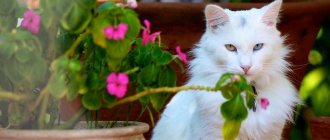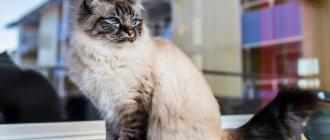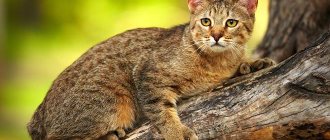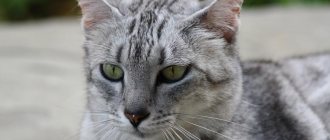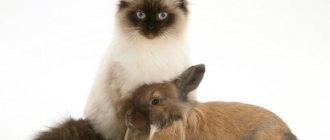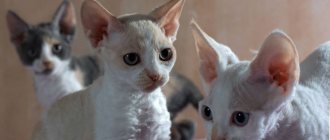Persian longhair breed
| Breed name | Persian longhair cat (Persian) |
| Path of occurrence | Aboriginal breed with further development |
| Country of origin | Armenia, Iran, Türkiye |
| Coat | Longhair |
| Lifespan | 15 – 20 years |
| Cost of a kitten | 5 – 15 thousand rubles. |
Diseases common in the breed
Despite its good health, like all animals, the breed is prone to certain types of diseases.
Persian cats have several hereditary defects:
- polycystic kidney disease (the growth of cysts filled with fluid in the animal’s kidneys is observed);
- hypertrophic cardiomyopathy (thickening of the walls of the heart ventricle occurs).
They are also susceptible to diseases such as:
- viral rhinotracheitis (a dangerous viral disease caused by the feline herpes virus);
- hip dysplasia (a consequence of high weight);
- ulcerative keratitis (occurs when nerve tissue is damaged, an ulcer forms on the eyeball, may be a consequence of diabetes in an animal);
- retinal atrophy (a serious disease that leads to complete blindness).
Get all the necessary vaccinations on time - this will greatly help prolong the life of your pet.
How long a Persian cat lives depends largely on the conditions of its maintenance and nutrition. The average lifespan ranges from 15 to 20 years. You should take into account the fact that spayed and neutered animals live a couple of years longer.
History of the origin of the Persian breed
Special cats with thick fur appeared in Persia, which is why their name appeared when Pietro della Valle, a traveler from Italy, came to the Middle East in the 17th century. It is he who should be thanked for the appearance of the Persians - he brought animals with large ears and a straight long nose to Italy.
Other mentions were made a hundred years later, when the French biologist Georges-Louis Leclerc described them in his writings. The engravings found show the similarity of Persian cats with Turkish Angoras - the ears are widely spaced, the nose is short, snub-nosed, and the skull is wide. In addition, some scientists assumed that cats could have appeared in Rus' and called them Russians, since it was in harsh cold conditions that they could acquire their thick fur.
Breeders became interested in Persian cats already in the 19th century, when in Great Britain they set out to change the appearance of cats. At an exhibition in 1887, Persian cats as we used to know them were recognized for the first time as a separate breed.
Persians began to gain their popularity at the end of the 19th century, when they were brought to the United States. Over time, after American modernization, a new type appeared - extreme Persians - the nose shortened and is approximately at eye level.
I consider Persian cats to be truly royal - their beautiful, flowing fur, sweet face and calm character have made this breed the most in demand.
Solid color
With this color, the cat’s coat color has one shade, without any markings. In addition to the three basic colors, cats of this type can have blue and cream colors, which are the result of lightening black and red, respectively, as well as lilac and chocolate.
Black kittens under 8 months of age may have uneven coloring. Their fur contains white hairs and gray spots, sometimes rust-colored hairs.
White kittens may have spots of different shades on their heads, but they disappear over time. Cats often have eyes of different shades. Also, some are born deaf, which is due to the gene that carries the color white. However, according to the results of breeding research, it was possible to achieve a high percentage of hearing cats.
Description of the breed
Persian standard
There are currently 4 main types of Persian cats recognized:
- The classic type (British) is outdated, with a noticeable nose, the edge of which is located 5-6 mm below the edge of the inner corner of the eye.
- Modern type (short nose) - have an open look, the bridge of the nose is raised. Thanks to the wide eyes, the nasolacrimal ducts are not deformed, and the animal does not have a gloomy expression on its face.
- Extreme type (American) - the breed description is characterized by a short nose, round forehead, low-set ears, and straight-set eyes. The earlobe is almost at the same level with the inner corner of the eyes.
- Pig type (piggy) - the convexity of the skull is almost not pronounced, low weight, weak bones. This type is derived from the extreme.
classical
modern
extreme
pig type
Regardless of the type, the following standard characteristics are distinguished:
- Body: massive but compact; the chest and stomach are wide, rounded; the tail is proportionally short, very fluffy; average weight for females is 3-4 kg, for males 5-6 kg.
- Coat: silky, soft long hair covering the entire body; There are more than 200 species of Persian cat colors, including the graceful white Persian chinchilla.
- Head: muzzle flattened, almost flat, bone wide; forehead is rounded; the nose is short and raised.
- Eyes: wide-set, large and expressive; eye color can be green, blue, brown, and can also differ from one another (colorpoints with blue eyes and chinchillas with green should be noted separately); friendly look.
- Ears: usually small, low set, rounded tips; hidden behind abundant fur.
- Limbs: paws are fluffy, thick, proportionally short relative to the body.
- Life expectancy: extreme Persians live up to 15 years, ordinary modern Persians under normal conditions can live on average up to 20 years.
Colors
- Solid (solid) - solid colors: white, black, blue, red (red), lilac, cream, chocolate. There are no patterns or streaks on the wool. Eye color is most often copper and dark orange or dark blue in white Persians.
- Bicolor is a combination of a primary color and white. The color of Persians is rare for Russian exhibitions, since breeding such a capricious spotted color requires a lot of effort. Bicolors should have at least 1/2 and no more than 2/3 white in color, with white spots on the head and tail desirable.
- Tabby - patterns on the fur: stripes, spots and marbles. Any basic coat color.
- Color point is the so-called Siamese coat color with dark spots on the face, paws and tail. Popular colors include brown, lilac, blue and black spots. Persian color-pointed cats were even identified as a separate breed - the Himalayan cat.
- Smoky is an amazing color in which each hair is conventionally divided into 2 color parts: a light base at the root and a dark color at the tip - tipping. At rest, the cat appears monochromatic, but when moving, the light undercoat becomes visible. Shades: black smoky, blue smoke, chocolate, tortoiseshell, lilac.
- Chinchilla - Golden and silver Persian chinchillas are now considered very popular and popular colors of the breed. Black tipping (the hair is colored only 1/8 with a dark tip) is evenly distributed on the back, sides, head and tail. The main color of gold is light apricot, while that of silver is pure white. A characteristic feature of chinchillas is the black rim around the eyes, nose and lips.
- Tortoiseshell is the color of Persian cats, in which there is a combination of two primary colors at once - red and black or their lightened analogues - cream and blue. This also includes the calico - a combination of tortoiseshell and white.
Munchkin
The main feature of these cats is their short legs. The first representative of the breed was the Blackberry stray cat, which was found in 1983 in the USA.
The breed is recognized by TICA and WCF.
CFA and GCCF refuse registration because they consider short legs to be a defect that reduces the quality of life of the animal.
Appearance
The head is shaped like a modified wedge, slightly rounded. The cheekbones are high and may be more noticeable in males. The ears are wide at the base, set high and wide. The eyes are almond-shaped.
The body is long, with a rounded chest and firm hips. The tail is equal to the length of the body and should be raised up when moving. The weight of an adult animal is 2–4.5 kg. The legs are short, about 13 cm.
The coat is allowed to be short or semi-long. In the second case, the animal may have tufts on its ears.
Short legs give munchkins a weasel-like appearance.
Character
Munchkins are cheerful, active and friendly pets. They love human society, but do not depend on it and tolerate loneliness well.
As a rule, they treat children and strangers peacefully.
They are very curious, love to explore unfamiliar places and new objects. They tolerate walking on a leash and long trips with their owners well.
One of the most curious features of the breed is that when a munchkin is surprised or interested in something, it stands on its hind legs, pressing its front legs to its chest and leaning on its tail. A cat can stand like this for a relatively long time.
For many owners, the munchkins' way of standing on their hind legs seems no less exotic than their short limbs.
Despite their short legs, munchkins move quickly, confidently and gracefully, and stomp quite loudly. The manner of movement is somewhat similar to that of ferrets or mongooses. They love active games, although they do not jump as high as other cats.
According to a number of reviews, munchkins tend to “borrow” and hide things they like in secluded places.
If a munchkin doesn’t have a cat’s house or is not happy with it in some way, the animal will try to build a home from “survival materials.”
Very intelligent cats, they know how to think, analyze, draw conclusions, they learn everything so quickly, even what they shouldn’t (for example, how to open drawers and doors). For comparison: I also have a noble cat, their thinking is quite different. If I throw a toy and it flies behind the sofa, the cat will jump on the back of the sofa and look where it fell. The cat will not climb onto the sofa, he will assess the situation and immediately crawl under the sofa, guessing that the toy is already there. If I point my finger in the corner and say that the toy is there, the cat will come up to me and look at the finger, the cat will go where I point.
Ainnka
https://irecommend.ru/content/manchkiny-lyubov-odnazhdy-lyubov-navsegda
Care
Short-haired individuals are combed once a week, semi-long-haired individuals - 2-3 times. The animal is bathed approximately once every 3 months.
Munchkins are prone to tartar formation, so they need to brush their teeth at least once a week.
Video: Munchkin - all about the breed
Gallery of photos of Persian cats
Solid colors
red
black
white
blue
lilac
chocolate
Bicolor - two-color
red bicolor
black bicolor
Blue bicolor
Lilac bicolor
Tabby
red tabby
black marble
brown tabby
golden tabby
red marble
Color point and smoky
black smoke
blue smoke
chocolate smoke
color point
color point
Chinchillas and turtles
golden chinchilla
silver chinchilla
tortoiseshell
calico
Tortoiseshell color
This type of coloring is characteristic only of females. Males very rarely have this color, and, as a rule, are not capable of reproduction. The fur of such cats is colored black and red, or their lightened varieties. The spots are evenly distributed throughout the body. The offspring of turtles have different colors.
A simple turtle is colored black and red, while red can have different shades. As a rule, shorter hairs are colored in light colors, and longer hairs are colored in dark colors.
Other types of tortoiseshell colors include blue-cream, chocolate-cream and lilac-cream.
Health
The lifespan of Persian cats is one of the longest - with a loving owner and favorable living conditions, a cat can live more than 20 years.
Unfortunately, these cats are predisposed to hereditary diseases. Among the most popular and frequently encountered are:
- Bladder stones.
- Polycystic kidney disease.
- Cystitis.
- Congenital liver problems.
- Progressive retinal atrophy.
If any symptoms occur, treatment and even surgery are necessary. That is why potential buyers are advised to be very careful when choosing a breeder to purchase a kitten; they need to carefully check the pedigree and make sure that there have been no previous cases of the disease.
Pros and cons of the Persian breed:
Child of star, fire and smoke
The history of the emergence of Persian cats, framed by mysterious myths, has its roots in the distant past. For example, one of the most famous and poetic legends says that once a magician was attacked by robbers, but, fortunately, the hero Rustam was nearby, who freed him. The grateful wizard asked his savior what to give him as a gift. However, the modest Rustam replied that all he needed was the starry sky above his head and a fire emitting a pleasant aroma of smoke.
Then the magician called to himself a small spark of fire, added a gray curl of smoke to it and removed the two most distant and brightest stars from the sky in order to obtain from these magical ingredients a small Persian kitten, which he gave to the brave Rustam as a companion. This legend explains how the Persian cat became the owner of long hair that flows like smoke, sparkling intelligence and starry eyes.
pixabay.com/maxmann
Character of the Persians
The obedient Persian is known for being quiet and sweet most of the time. They are affectionate and picky, they give all their attention to their owner, but at the same time they are wary of house guests.
Important! Persian cats make excellent companions for their owner's family - they are calm and do not fuss unreasonably.
The Persian cat's personality is very calm; loud environments are frowned upon. Their usual needs and activities include eating, playing with toys, and napping during the day. And the most important thing for them is a lot of love, which a caring owner will be able to give to her by carefully combing her fur.
Such cats are unlikely to jump on your curtains or chew your wallpaper. While the family is not at home, the quiet cat prefers to be the decoration of the chair, waiting for his evening portion of care.
Characteristics and habits of Persian cats
The Persian cat is not only immensely charming, but also very obedient, so from a young age he will simply fit perfectly into any home environment. The docile nature of this animal allows it to easily understand and accept the rules of behavior dictated by the owner of the home.
Raising a kitten takes place without unpleasant surprises, since close contact quickly arises between it and its loving owner. As the Persian pet grows up, it lends itself well to simple training, which can bring it even closer to humans. And numerous reviews from the owners of these luxurious animals testify to the extraordinary intelligence and intelligence of the Persians, as well as their affectionate nature. That is why these fluffies take any disapproval or rudeness from the owner very close to the vulnerable cat’s heart.
The whole family can be endlessly touched by the habits of Persians, especially since the baby is ready to make friends with both its younger members and other pets - from hamsters to parrots. Children also love to tinker with shaggy cats, however, the latter should still be explained that they should not bother the cat too much with affection if he is not very inclined towards them at some point.
Differences in appearance and character: Persian, British Longhair and exotic
| Persian cat | British longhair cat | Exotic shorthair cat | |
| Peculiarities |
|
|
|
| Character |
| isolated and independent, calm temperament | calm, affectionate and friendly character |
| Difficulties |
|
| Grooming does not require much effort and time; dense wool does not need to be combed frequently |
| Dimensions | Average weight 3-5 kg, male 4-6 kg | Average weight 4-7 kg | The average weight of females is 5 kg, males up to 7 kg |
| Nutrition | Many prohibited foods due to digestive characteristics | The amount of food should be strictly measured, prone to overeating | They are demanding on the diet, most often they use specialized industrial feed of super-premium class and higher |
Savannah
This young breed is the result of crossing wild servals and domestic cats. The first viable kitten was born in 1986.
At the moment, savanna is only recognized by TICA. Other organizations refuse registration due to the lack of stable characteristics in the breed.
Appearance
These are large animals, with a body and tail up to 135 cm in length. Weight from 7 to 15 kg.
The head is wedge-shaped, relatively small. The whisker pads are weakly expressed. The nose is wide. The ears are large, very wide at the base.
The body is elongated, with a strong chest, strong shoulders and hips. The limbs are long, the groin line is lean.
The coat is short and thick, with leopard spots.
The F1 generation, that is, obtained directly from the mating of a wild and domestic animal, has the most striking characteristics of the breed. Males from these matings are sterile until the 4th–5th generation, so females are mated with domestic cats, and the signs of wild blood gradually fade.
F1 generation cats are most similar to wild animals
Character
With proper upbringing, it is an intelligent and obedient pet. He gets attached to people, loves to spend time with them and may even wait near the door when he gets home from work. At the same time, he calmly endures loneliness.
Representatives of the breed are distinguished by curiosity, courage and mobility. They need plenty of space to play, otherwise the behavior can become destructive.
Savannah needs room to play
Savannah usually gets along well with other cats and dogs, and prefers to be friends with the latter if they recognize her as their “leader”.
These cats love water and, if possible, willingly swim in pools and ponds. They love to throw toys into a full bath and then catch them with their paws.
They jump up to 2.5–3 m in height, so it is not advisable to keep fragile things on the top shelves.
In an animal of the F1 generation, after the age of three, wild character traits may intensify. It is strictly not recommended for families with children to have such a cat.
Care
The animal should have enough space to burn off its energy, ideally an enclosure with a mini-pool attached to the house. In addition, it is advisable to walk, like for a dog, for 1–2 hours.
The coat is combed once a week.
Savannah does not tolerate cold well, so in winter you need to take care of insulating your house.
Video: origin and description of the Savannah cat breed
Possible problems
The Persian breed is considered quite whimsical, so it is not recommended to have such a cat for constantly busy people: after all, additional time is required to care for the coat
It is not recommended to have a cat of this breed if there are many children in your house, but they will be very happy with the tender and affectionate attention of children.
Important! Persian cats contain a lot of allergenic protein and spread it very actively, which is why they are considered one of the most dangerous breeds for allergy sufferers. Increased shedding, watery eyes and nasal discharge are dangerous.
Persians are very domesticated and affectionate animals, so it is quite difficult for them to get along with other cats or dogs. Also, it is not recommended to let them go outside, as their fur is very difficult to clean from debris or leaves.
Toilet
Persians have a very difficult time litter box training. Most kittens of this breed are so stubborn in terms of toileting that many owners strive to punish them. However, you should be patient. Over time, the kitten will visit the litter box consistently.
Care
The Persian cat can rightfully be called one of the most demanding of attention and care. What requires most attention is a chic fur coat and a balanced diet.
Wool
The most important thing in caring for a Persian cat is to understand that he will need daily care. This long, beautiful coat by itself cannot remain clean and tangled: tangles of the undercoat can form very quickly, which causes great inconvenience to the animal, and it is very difficult to comb them out.
The pet must be gently but thoroughly combed every day, first soothing it with smooth strokes, and then carefully combing it with a special long-toothed brush according to the hair growth. At the end of the procedure, you need to use a spray with an antistatic effect.
Advice! A good purchase would be a furminator - a special comb-trimmer with frequent metal teeth, which will ease the spring-autumn periods of shedding in Persians.
Bathing is not the most favorite procedure for cats, so the optimal frequency is once a month. After washing to dry, it is better to use a hairdryer on low power to avoid drafts and the likelihood of a runny nose and colds.
How to cut a Persian's hair is a very popular request; however, cats do not require a specialized haircut, but sometimes matted fur needs to be cut off. Grooming Persians can be a solution for owners and pets who live in hot and humid climates. For the summer period, the hair from the body is cut off, without affecting the head, tip of the tail and toes.
It is important to keep the litter box clean as droppings and litter pellets can get stuck in paws or on thick fur. If you don't clean it out scrupulously, the Persian may become stubborn and start shitting in the wrong place. Some Persian owners prefer to slightly shorten the hair between the toes, which reduces the problem.
Nutrition of Persian cats
Persians often have problems with the digestive tract, so their nutrition must be approached with particular seriousness.
The basis of their natural diet should consist of lean meat, which is given boiled, baked in the oven or even raw. Several times a week you can add organ meats or fish. In addition, cats also receive vegetables, most often boiled carrots, cauliflower or broccoli, zucchini and pumpkin. Be sure to add low-fat fermented milk products (yogurt, kefir, cottage cheese) to your animal’s diet.
If you decide to feed your cat natural food, then you need to additionally add age-appropriate vitamins and taurine to the diet.
Important! As an alternative, you can use ready-made food, but it is not recommended to choose manufacturers from the economy segment. What you feed your cat determines its lifespan.
Many experts believe that cats after castration are less active, eat more and begin to gain weight, but this is not entirely true. If you correctly calculate the daily ration and prepare a diet with a limited fat content, and also keep your cat busy with active games, then weight gain will not occur.
Advice! Buy stable, wide, but not very deep bowls for water and food so that your Persian is less likely to stain the hair on his face while eating.
Dry food for Persians
The Persian breed is so popular and numerous that special food is produced for Persians to maintain the beauty of the coat and its easy removal from the intestines. Popular brands:
- Royal Canin Adult Persian is a specialized food for Persians from Royal Canin.
- Pro Plan Optiderma Elegant – for healthy skin and coat.
- Grandorf Cat Indoor will not only help maintain the beauty of the coat, but will also reduce allergic reactions in cats with sensitive digestion.
- Orijen Cat 6 Fresh Fish - small granules of food are perfect for Persians with extreme stops, so cats will not need to open their mouths too much when eating. Origin belongs to the holistic class.
Caring for ears, eyes and claws
The ears should be cleaned with a cotton swab soaked in a special lotion once a week.
Since the eyes of Persian cats have specific tear ducts, they regularly secrete secretions, which is why the eyes often water. It is difficult to remove discharge without causing inconvenience to the cat, so dried crusts should be wiped with a cloth and eye care product.
Regular nail trimming is necessary for the animal; you can do this yourself using a nail clipper: you need to carefully cut off only the tip of the claw to avoid injury to the vessel inside.
Walking your pet
Persian cats are rarely taken for walks: they are calm in nature and do not want to go on a trip. It is enough for them to be in the space of the apartment, and they can watch everything that happens from an open window.
If the owner has a private house and prefers to let the cat outside, then experts recommend fencing off a section of the garden for him where he could spend time, but even in such conditions he must be constantly monitored. And don’t forget to treat your cats for ticks and worms, and for the summer, you can purchase a collar impregnated with an anti-parasite agent.
Features of caring for a Persian cat
The main difficulty that the owner of a Persian cat faces in the process of caring for him is, of course, tidying up the animal’s fur. It is extremely long, and therefore requires daily attention in the form of combing. Otherwise, tangles will very soon form on your Persian’s fur coat and there will be no opportunity to sort out the tightly woven fine hairs.
To make combing easier, some breeders recommend adding a little talc to the coat. Fortunately, the Persian cat treats grooming with understanding and quickly gets used to it, since they begin to care for it already from the tender age of a kitten. But this fluffy doesn’t really like to wash, but for the sake of the external beauty and health of the coat and skin, you still have to do it - with the help of special shampoos. And one more important point: since a clean animal, despite careful care from the owner, still often licks its fur coat, it is advisable to give the pet a special paste so that the numerous fur that gets into the stomach does not cause harm to your pet.
A Persian cat's claws can be trimmed once every couple of weeks. We assure you: due to the calm nature of the pet, this procedure in most cases will not cause problems for the owner.
pixabay.com / @lindarczyk
How to choose a Persian kitten
First of all, you should pay attention to the purpose of the choice - if you want to participate in exhibitions, then the mother cat must be selected from a special club with a mandatory ideal pedigree and the cost will be correspondingly high. If the kitten is for home and for your soul, then you need to find out from the breeder about the type of breed, the health of the offspring, and the presence of diseases in its parents.
Advice! The breed type appears in the baby at about 2-4 months, this is the optimal time for choosing.
It is advisable to take the kitten out of its familiar environment so that you can assess its contact with other animals, find out whether it feeds itself and whether it is potty trained. A healthy kitten should show interest in everything around it, including you. He should be clean and his coat should be smooth.
The price of kittens varies depending on the type of cat and color; eye color is also important. The most expensive colors will be golden and silver chinchillas, solid (snow white, black), smoke and tortoiseshell calicos. On average, breeders offer to buy a two-month-old kitten for 5 – 15 thousand rubles.
blue kitten persian
gray bicolor
Sphinxes
Hairless cats appeared relatively recently, but managed to gain enormous popularity.
Main breeds
There are several breeds of Sphynx.
Canadian
The oldest variety. The first representative was the kitten Prune, born in Toronto. Subsequently, most of the breeding work took place in the USA and Holland. The breed is recognized by all major felinological organizations.
The head is slightly longer than wide. The ears are large, the muzzle has pronounced cheekbones and a strong chin.
The body is muscular, heavy, with a convex belly. Legs are strong. Short hair is allowed on the paws, tail, ears, and scrotum. The rest of the body may be completely bald or covered with down of no more than 2 mm.
Canadian Sphynxes appeared as a result of a random mutation
Based on this breed, a number of hybrids have been bred, for example, elves - hairless cats with curled ears.
Don
The breed comes from Rostov-on-Don. Its ancestor was the cat Varvara, who was picked up on the street.
The breed is recognized by the WCF.
The head is wedge-shaped, the cheekbones and eyebrows are sharply defined. The ears are large. The body is strong, with a deep groin line.
Donchak dogs can be completely hairless or with coat types such as:
- flock - hairs are almost invisible in appearance;
- velor - hairs 2–3 mm;
- brush - relatively long and stiff wool.
The latter type is used for breeding and participates in exhibitions, but without the right to receive titles.
Completely hairless Don Chaks are considered the most striking and valuable representatives of the breed.
Peterbalds
Breeders purposefully created this breed by crossing the Don Sphynx and an Oriental cat. In further work, animals of the Siamese-Oriental group were also used.
The breed is recognized by CFF, TICA and WCF.
The head is wedge-shaped, narrow. The ears are large, the tips are spread apart. The eyes are almond-shaped. The physique is oriental: the body is elongated, flexible and thin, the limbs are long and slender. The coat types are the same as those of the Don Sphynski.
Peterbalds adopted the leanness and grace from their oriental ancestors
Character
Sphynxes are good-natured and affectionate pets that are extremely in need of human society. They prefer to spend as much time as possible with the owner, while actively trying to participate in his affairs, which is why they can be intrusive. Loneliness is very difficult to tolerate.
At the same time, they never curry favor with people, preferring equality. They are inquisitive and smart, capable of funny tricks and pranks. They are trained to walk on a leash. They are very active in childhood. They are not vindictive and patient with children. They get along peacefully with other non-aggressive animals. They can be quite talkative. This is especially often said about Peterbalds, who inherited this trait from their “eastern” ancestors. May be unclean when going to the toilet.
Of all the Sphynx breeds, I liked the Canadian Sphynx the most in appearance and character. […] After only half an hour of being in our family, the little mischief immediately made it clear that not a single thing in the house could be done without her: bills, drawers, cabinets, bags, a manicure lamp, tools - all new items that happen to be nearby are a must must go through strict control of Blueberries! She is very curious.
timofeeva_natalia
https://irecommend.ru/content/pro-nashego-druga-i-chlena-semi-kanadtsa-cherniku-mnogo-teksta-pro-zavodchikov-povedenie-kha
Care
The skin of Sphynx cats produces a specific brown “sweat”, so they need to be bathed about twice a month. In addition, the animal is regularly wiped with veterinary wipes.
It is important that the house is warm. Sphynxes love to bask in the sun, and in the heat they can get sunburned or get heatstroke. Dry air, feeding errors and a number of other factors lead to flaking of the skin. In this case, the pet can be lubricated with baby oil. You cannot indulge the immoderate appetite of these animals.
Video: features of caring for sphinxes
Breeding
Breeding purebred Persians is a big responsibility; it will take a lot of effort and money to start your own business. The choice of an ideal mating partner must be very serious, since only breeding cats are chosen for owners of high-breed cats.
But choosing the best individuals does not always lead to ideal offspring: kittens are often born with various defects in their appearance. Therefore, many breeders prefer a compensatory breeding method, in which both individuals have some defects in appearance, but are necessarily different.
If the owner has seriously decided to engage in crossing high-breed cats, then one should very carefully study all the possibilities of crossing non-ideal partners in order to establish the possibility of anomalies in the exterior and their transmission to offspring.
| Nursery name | City | Official website of the nursery |
| BAR'LAND RUS | Moscow | https://barlandrus.ru/ |
| LumiCat | Moscow | https://www.lumicat.ru/ |
| FLUFFY FLOCK | Moscow | https://fluffycat.ru/ |
| SNOW DREAM | Moscow | https://snow-dreams.ru/ |
| HELGA'S CAT | Saint Petersburg | https://helgas.name/ |
| MATIOLLA | Samara | https://matiolla.com/ |
Interesting Facts
During the existence of Persian cats, a lot of interesting things happened to the breed:
- These animals were the favorites of Richelieu himself. Before his death, the cardinal bequeathed lifelong maintenance to his Persians. But since cats were then considered the embodiment of the devil, the superstitious courtiers had their own way and burned Richelieu’s pets at the stake.
- These animals took part in the breeding of exotics. A Persian cat was crossed with an American shorthair. As a result, snub-nosed kittens with smooth fur were born.
- Some experts believe that initially the fluffy cats from which the Persians originated appeared in Russia, from there they came to the East, and then to Europe.
Health and susceptibility to disease
Persian cats are gentle and fragile creatures that live on average 13-15 years. Due to the special structure of the muzzle, representatives of the breed are predisposed to breathing problems and may snore in their sleep.
Persians also have a tendency to:
- to hypertrophic cardiomyopathy;
- polycystic kidney disease;
- idiopathic dermatitis;
- eye infections;
- gingivitis.
Feeding the cat
Persian cats eat both commercial and natural food equally well. Therefore, when choosing a diet for your pet, you can be guided by your own preferences.
It is advisable to give premium, superpremium or holistic class products to Persian cats that eat dry food. These foods contain all the necessary substances and no questionable additives.
The best options are the following brands of food:
- Royal Canin;
- Farmina;
- Acana;
- 1st Choice.
The diet of Persian cats on a natural diet is designed so that fresh, lean meat predominates in it. The pet is also given:
- boiled vegetables;
- porridge with water;
- offal;
- sea fish;
- eggs;
- dairy products.
Neither a purebred nor a half-Persian cat should eat sausage, pastries, sweets, bones and pork. Also, you should not give your animal salty, fatty, spicy or fried food.
On a note. With a natural type of nutrition, the Persian cat is given vitamin and mineral complexes twice a year.
Education and physical activity
Calm and understanding Persians quickly get used to the rules established in the house. They learn to go to the litter box and use a scratching post without any problems. Persian cats perfectly recognize intonations and subtly detect dissatisfaction in the owner’s voice.
On a note. Persians are easily wounded creatures with a delicate mental organization. That's why you can't beat them. As punishment, you can throw a newspaper or splash water at a Persian cat.
Representatives of this breed value comfort and do not need walks. They are much more interested in observing the world around them from the windowsill. Although the phlegmatic Persian cats do not have the habits of a hunter, they are happy to run after an artificial mouse or ball.



